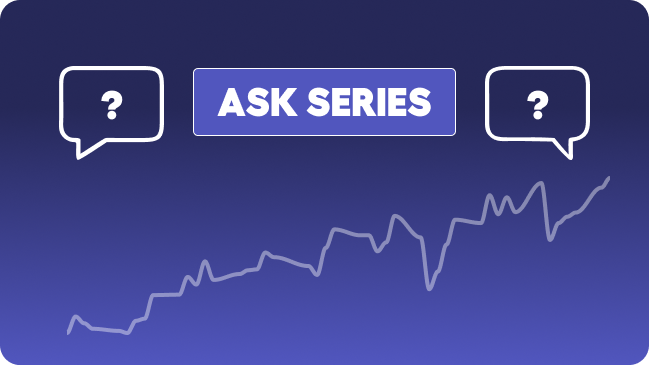

Article
— savings
Ask : Should I Invest My Down Payment?
Welcome to our Ask series, where we tackle your questions about personal finance and investing. Want to see your question answered here? Reach out to us on social media and we’ll try to address it in a future column.
I’m saving for a house. Should I invest my down payment or keep it in cash?
As you decide whether to invest your down payment or keep it in cash, you’re primarily making a decision about risk. Investing, by definition, involves some risk—but that’s why it can offer higher expected returns over the long run. Cash is very low risk, but it is likely to offer lower expected returns.
In this post, we’ll give you a framework for thinking about risk in the context of your down payment so you can decide what’s right for you. We’ll highlight the tradeoffs related to three options you might consider:
- Keeping your down payment in cash
- Investing your down payment in a low-risk investment like US Treasuries
- Investing your down payment in a diversified portfolio
The argument for keeping your down payment in cash
Keeping your down payment in cash is a great option if you expect to buy a home imminently or if you are unwilling or unable to take any risk to your principal. If you keep your down payment in a savings account or high-yield cash account, you’ll have a high degree of certainty that your money will be there when you need it. However, you’ll be making a tradeoff when it comes to expected returns.
Over long periods of time, cash is unlikely to earn enough interest to keep up with inflation. So if you keep your down payment in cash for long enough, you could actually lose buying power. If you plan to buy a house imminently, this is unlikely to be an issue. But over longer periods of time, you could be leaving potential returns (and thus housing budget) on the table.
If you do decide to keep your down payment in cash, we suggest picking an account with a very competitive APY and adequate FDIC insurance. Many banks pay next-to nothing in interest and, as insured depository institutions, are limited to $250,000 in FDIC insurance per account holder. But the Itrust Cash Account offers an industry-leading 4.50% APY and up to $8 million in FDIC insurance ($16 million for joint accounts) through our partner banks. Plus, the Cash Account comes with no account fees and your money is readily available when you need it. By choosing a good home for your cash, you can ensure your down payment earns a competitive interest rate and is well protected in case of an unforeseen event.
The argument for investing your down payment in a low-risk investment like US Treasuries
While holding cash can feel psychologically rewarding, it could make more sense to invest your down payment in a low-risk investment like US Treasuries. While they have a lower expected long-term return than a diversified portfolio of US equities, US Treasuries can offer a steady yield until maturity and the interest you earn is exempt from state and local income taxes. At the same time, US Treasuries are backed by the full faith and credit of the US government, which is why they are considered among the safest investments in the world. If held to maturity, US Treasuries pose virtually no risk to your principal, although you run the risk of losing some principal if you sell before then (if interest rates go up, the price of the bond may decrease).
Because of these benefits, US Treasuries can be a very attractive and low-risk way to invest your down payment whether you’re buying a home in a few months or a few years. You could argue that US Treasuries are the sweet spot between holding your down payment in cash and investing it in a diversified portfolio. And if you want to minimize the risk associated with interest rate fluctuations, you could consider building a US Treasury ladder (a type of bond ladder) with US Treasuries of varying maturities.
At Itrust, we built our Automated Bond Ladder (a ladder of US Treasuries) to make it easy to benefit from a bond ladder strategy without any of the hassle it normally entails for a low annual advisory fee of 0.25%. The Automated Bond Ladder can be a great way to invest your down payment if you want to keep your level of risk very low and take advantage of state income tax exemptions, and it comes with up to $500,000 of SIPC insurance. When you’re ready to buy a home, your ladder is very liquid and there are no early withdrawal penalties. You can even set a target withdrawal date for your Automated Bond Ladder, which can be useful if you have a timeline you’re fairly confident in.
The argument for investing your down payment in a diversified portfolio
Finally, if your time horizon for buying a home is five or more years away, you might consider keeping your down payment in a diversified portfolio of low-cost index funds. It’s true that this type of portfolio (like Itrust’s Classic portfolio) comes with more risk than cash or US Treasuries, but that risk could also get you higher expected returns over the long run. There’s also a well established relationship between risk and time horizon, and the longer you stay invested, the lower your probability of loss.
As you get closer to actually buying a home, it could be wise to shift your down payment from a diversified portfolio to one of the lower-risk options discussed above. The reason for this? Financial markets are unpredictable in the short term and can be volatile. It would be unfortunate if the market declined steeply at the exact time you needed to liquidate your investments to purchase a home—you could end up with a smaller down payment than you’d hoped for, and you’d also be selling investments when they’re down (which is nice to avoid if you can).
Key takeaways: Should you invest your down payment?
There’s no one-size-fits-all answer to whether or not you should invest your down payment, but there are some rules of thumb to keep in mind:
- If you plan to buy a house imminently, it probably makes sense to keep your down payment in cash.
- If you plan to buy a house soon (a few months to a few years from now) and want to earn a higher yield with very little risk, consider investing in US Treasuries.
- If you’re at least five years away from buying a home and are willing to take on additional risk in order to potentially grow your down payment, a diversified portfolio of index funds could be a good fit.
It’s also an option to split your down payment if you believe you can benefit from a variety of approaches—you don’t have to keep all of it in one place. For instance, you could keep half of your down payment in cash and the other half in a diversified portfolio of low-cost index funds if you wanted to balance out a higher-risk option with the lowest risk option.
We hope this helps!


